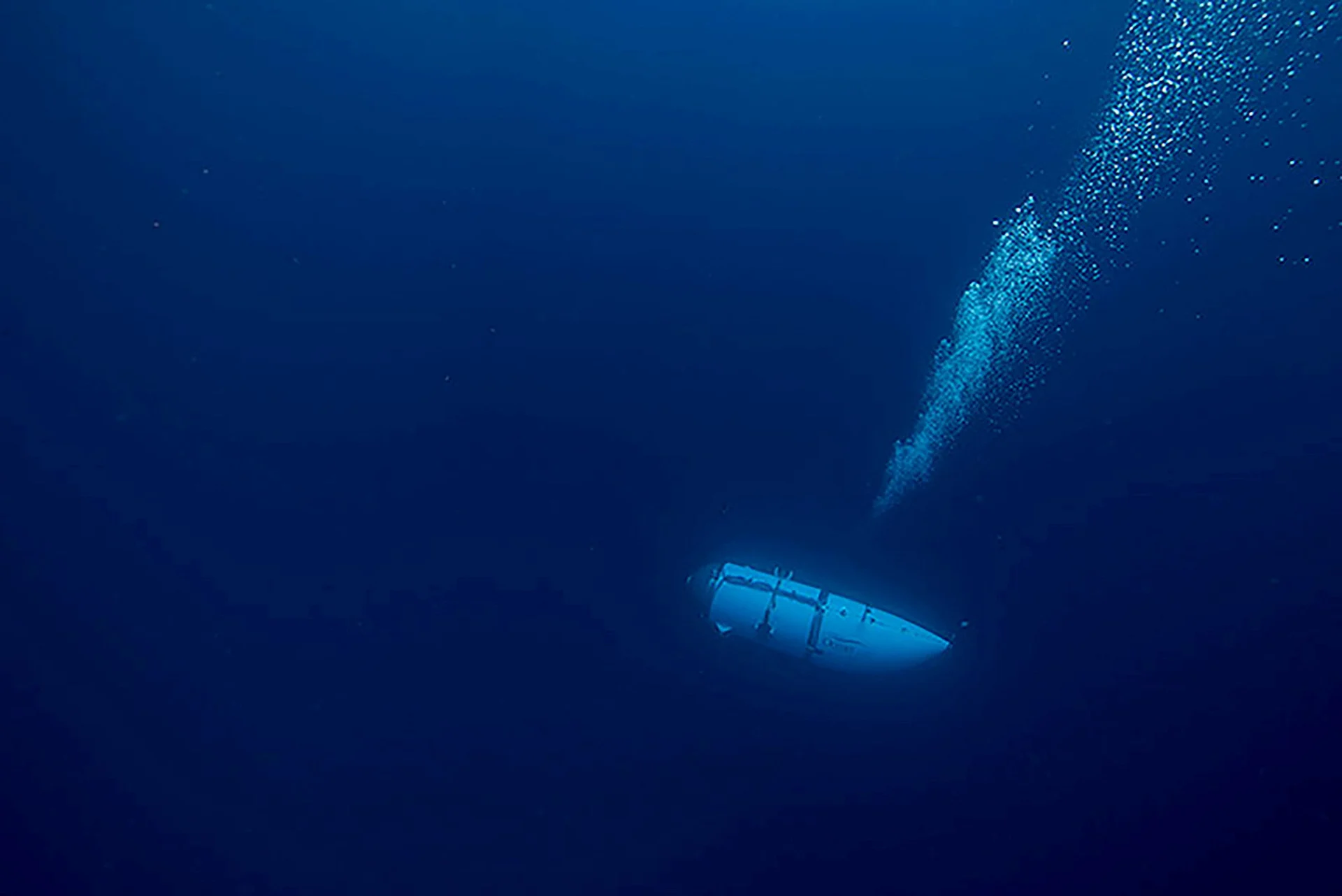
Titanic tourist sub missing for third day as search teams race clock
By Joseph Ax and Brendan O'Brien
(Reuters) - Rescuers searched a vast swath of the North Atlantic for a third day on Tuesday, racing against time to find a missing tourist submarine that vanished while taking wealthy passengers on a voyage to the wreck of the Titanic in deep waters off Canada's coast.
The 21-foot submersible Titan is built to stay underwater for 96 hours, according to its specifications - giving the five people aboard until Thursday morning before air runs out. One pilot and four passengers were inside the miniature sub early on Sunday when it lost communication with a parent ship on the surface about an hour and 45 minutes into its two-hour dive.
RELATED: Search underway for tourist submarine exploring Titanic wreckage
As Canadian and US authorities stepped up the search, previous questions about the safety design and development of the submersible by its owner, U.S.-based OceanGate Expeditions, came to light.
The wreck of the Titanic, a British ocean liner that struck an iceberg and sank on its maiden voyage in April 1912, lies about 900 miles (1,450 km) east of Cape Cod, Massachusetts, and 400 miles (644 km) south of St. John's, Newfoundland.
RELATED: What are submersibles, how do they communicate, and what may have gone wrong?
U.S. and Canadian aircraft have searched more than 7,600 square miles of open sea, an area larger than the state of Connecticut, U.S. Coast Guard Captain Jamie Frederick told reporters at a press conference on Tuesday.
The Canadian military has dropped sonar buoys to listen for any sounds that might come from the Titan, and a commercial vessel with a remote-controlled deepwater submersible was also searching near the site, Frederick said.
Separately, a French research ship carrying its own autonomous deep-sea diving vessel was dispatched to the search area at the request of the U.S. Navy and was expected to arrive Wednesday night local time, the Ifremer research institute said.

(REUTERS: Atlantic Productions - Titanic wreckage)
Those aboard Titan for a tourist expedition that costs $250,000 per person included British billionaire Hamish Harding, 58, and Pakistani-born businessman Shahzada Dawood, 48, with his 19-year-old son Suleman, who are both British citizens.
French explorer Paul-Henri Nargeolet, 77, and Stockton Rush, founder and CEO of OceanGate Expeditions, were also reported to be on board. Authorities have not confirmed the identity of any passenger.
Rescuers face significant obstacles both in finding the Titan and in saving the people aboard, according to experts.
If the submersible experienced a mid-dive emergency, the pilot would likely have released weights to float back to the surface, according to Alistair Greig, a marine engineering professor at University College London. But absent communication, locating a van-sized submersible in the vast Atlantic could prove challenging, he said.
The submersible is sealed with bolts from the outside, preventing the occupants from escaping without assistance even if it surfaces.

The Titan submersible, operated by OceanGate Expeditions to explore the wreckage of the sunken SS Titanic off the coast of Newfoundland, dives in an undated photograph. OceanGate Expeditions/Handout via REUTERS
If the Titan is on the ocean floor, a rescue effort would be even more challenging due to the extreme conditions more than 2 miles beneath the surface. The Titanic lies 12,500 feet (3,810 meters) underwater, where no sunlight penetrates. Only specialized equipment can reach such depths without being crushed by the massive water pressure.
"It's really a bit like being an astronaut going into space," said Tim Matlin, a Titanic expert. "I think if it's on the seabed, there are so few submarines that are capable of going that deep. And so, therefore, I think it was going to be almost impossible to effect a sub-to-sub rescue."
Safety issues raised before
The ability of the tourist sub's hull design to withstand such depths was questioned in a 2018 lawsuit filed by OceanGate's former director of marine operations, David Lochridge, who said he was fired after he raised safety concerns about the vessel.
OceanGate said in its breach-of-contract suit against Lochridge, who is not an engineer, that he refused to accept the lead engineer's assurances and accused him of improperly sharing confidential information. The two sides settled their court case in November 2018.
Neither the company nor its lawyer, Thomas Gilman, immediately responded to requests from comment from Reuters.
An attorney for Lochridge declined to comment.
Several months before the suit was filed, a group of submersible industry leaders wrote a letter to OceanGate warning that the "experimental" approach" to the sub's development could result in "minor to catastrophic" problems, the New York Times reported.

The port bow railing of the Titanic lies in 12,600 feet of water about 400 miles east of Nova Scotia as photographed earlier this month as part of a joint scientific and recovery expedition sponsored by the Discovery Channel and RMS Titantic. Reuters/File photo
U.S. President Joe Biden was "watching events closely," White House national security adviser John Kirby said on Tuesday. Britain's King Charles asked to be kept fully apprised of the search, a Buckingham Palace source said, as Dawood is a longtime supporter of the monarch's charity, the Prince's Trust International.
OceanGate said it was "mobilizing all options," and U.S. Coast Guard Rear Admiral John Mauger told NBC News the company was helping to guide the search efforts.
"They know that site better than anybody else," Mauger said. "We're working very closely with them to prioritize our underwater search efforts and get equipment there."
Billionaire aboard
OceanGate schedules five week-long "missions" to the Titanic each summer, according to its website.
David Pogue, a CBS reporter, rode aboard the Titan last year. In a December news report, he read aloud the waiver he had to sign, which noted the submersible had "not been approved or certified by any regulatory body" and could result in death.
In an interview on Tuesday, Pogue said OceanGate has successfully ventured to the wreck around two dozen times and that the company conducts a meticulous safety check before each dive.

British billionaire Hamish Harding, who is said to be among the passengers onboard the submarine that went missing on trip to the Titanic wreckage is seen in this handout picture taken in flight, July 2019. Courtesy of Jannicke Mikkelsen/via REUTERS/ File photo
"They treat this thing like a space launch," he said.
Harding, a UAE-based businessman and adventurer who is chairman of Action Aviation, posted a message on Facebook on Saturday, saying: "This mission is likely to be the first and only manned mission to the Titanic in 2023."
Fellow tourist Dawood is vice chairman of Engro, one of Pakistan's largest conglomerates.
The sinking of the Titanic, which killed more than 1,500 people, has been immortalized in books and films, including the 1997 blockbuster movie "Titanic," which renewed popular interest in the wreck.
(Reporting by Joseph Ax and Brendan O'Brien; Additional reporting by Natalie Thomas, Aiden Nulty, Kanishka Singh, Ismail Shakil, Steve Scherer, Steve Holland, Daniel Trotta and Ariba Shahid; Editing by Edmund Blair, Janet Lawrence and Nick Zieminski)
Header image: OceanGate Expeditions/Handout via REUTERS.









